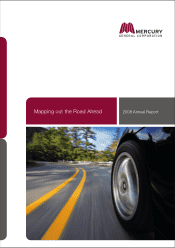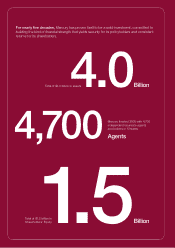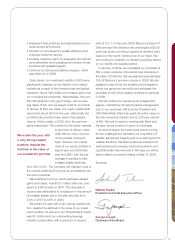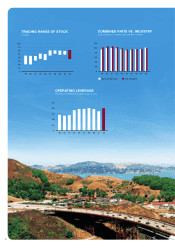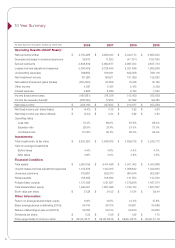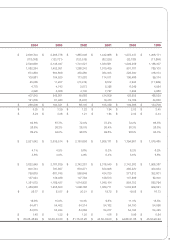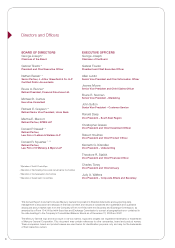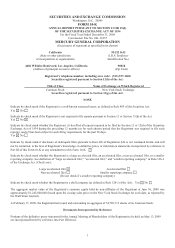Mercury Insurance 2008 Annual Report Download - page 4
Download and view the complete annual report
Please find page 4 of the 2008 Mercury Insurance annual report below. You can navigate through the pages in the report by either clicking on the pages listed below, or by using the keyword search tool below to find specific information within the annual report.
2
an increase in adverse development, which reached
$57 million for 2008 compared to $26 million in
2007. Lower average premiums in our California
homeowners and personal auto lines also contribut-
ed to the combined ratio deterioration. In California,
we have filed for an approximate 2% rate increase in
our personal auto line in order to improve our results
in this, our largest market.
Our non-California operations produced a com-
bined ratio of 115.7% in 2008 compared to 104.4%
in 2007—clearly unacceptable. This was primarily
due to our results in Florida and New Jersey, which
produced a combined underwriting loss of $71 mil-
lion in 2008, compared with an underwriting loss of
$21.4 million in 2007. Included in the 2008 under-
writing loss was approximately $26 million in adverse
loss and loss adjustment expense development. This
compares with $7 million of positive development
in 2007.
In Florida, our second largest state, improvements
in our claims handling have significantly reduced the
severity of our bodily injury claims, while expenses
related to defending and containing bodily injury
indemnity costs have increased. Although we are
pleased with the operational improvements made in
Florida, we still have a ways to go to meet our profit-
ability target and have filed for a 6% rate increase
that should go a long way towards getting us there.
New Jersey is our most challenging state. The
laws governing Personal Injury Protection (PIP) cov-
erage led to a longer claims tail than in most other
states and, with our short operating history, it has
been difficult for us to estimate loss reserves.
Consequently, we experienced adverse loss devel-
opment in 2008 of $28 million and $8 million in 2007.
During 2008, we began relying less on industry data
and more on internal Company data to estimate our
reserves, however, it is still reasonable to expect
reserve volatility in the future.
In New Jersey, we are taking various steps to
improve our results. Effective January 1, 2009, we
put in place a new pricing plan, which improves our
risk segmentation and increases overall rates by 5%.
In addition, we have tightened our underwriting pro-
cedures, made changes to our claims process for
PIP and Bodily Injury coverage and continue to work
with our agents to improve results. We believe that
claims process changes are having a positive impact
on our PIP costs for the
current accident year and
should begin to work
themselves into the finan-
cial results in the future.
Our Company-wide
expense ratio grew from
27.4% in 2007 to 28.5% in
2008. The increase was
primarily due to three areas: technology-related
expenditures, the establishment of our new product
management function and expenses related to the
acquisition of Auto Insurance Specialists, Inc. (AIS).
In addition, fixed costs have not declined in propor-
tion to the decline in premiums.
In an effort to improve our cost structure, we have
taken a number of difficult but necessary steps that
will help offset the increase in both our loss adjust-
ment and underwriting expense ratios. Those steps
include a salary freeze for all employees, a hiring
freeze, except for certain positions, and a temporary
suspension of our 401(k) matching program. In addi-
tion, in March 2009, we reduced our work force by
over 7%. This was a painful decision to make but,
after careful consideration, it was deemed necessary
for the long-term benefit of the Company. The net
annual cost savings from these cost cutting mea-
sures will be over $20 million.
In addition to operational efficiencies, growth and
profitability are also necessary for Mercury’s long-
term success. Consequently, we have identified the
following key strategies to help grow our business,
improve our service and enhance our bottom line:
• Implement improved pricing segmentation and
overall rate adequacy.
• Continue to invest in our technology to make it
easier for our agents, customers and employees to
transact business with us, including the roll out of
our new Web-based agent interface program,
Mercury First.
In addition to operational
efficiencies, growth and
profitability are also
necessary for Mercury’s
long-term success.

